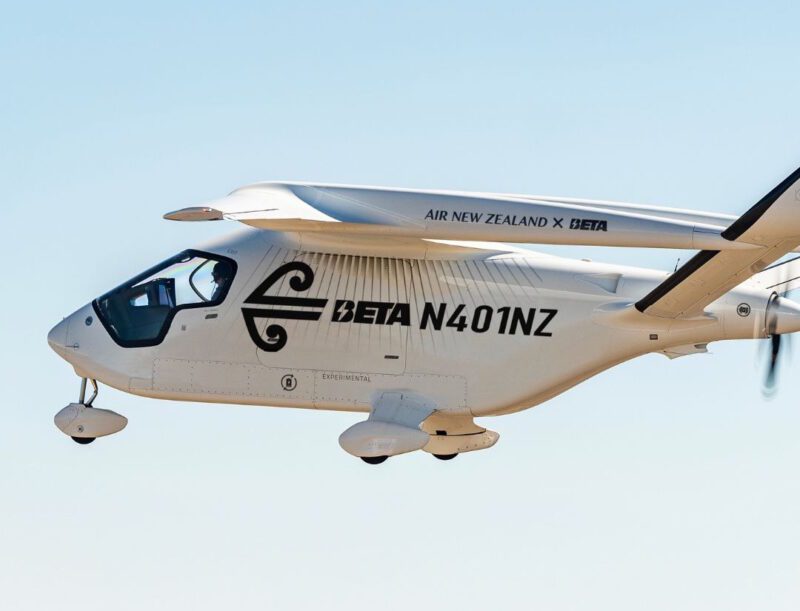The first electric aircraft to bear the Air New Zealand brand name took to the skies late last week for its first test flight in the land of the long white cloud.
Air New Zealand teamed up with American global aviation innovator Beta Technologies to test one of its Alia electric conventional take-off and landing (CTOL) aircraft.
Leased for four months as part of a technical demonstrator programme, Air New Zealand will have the opportunity to see how the Alia CTOL aircraft performs in local conditions, as well as start familiarisation for pilots and engineering teams.
The demonstration also serves as the perfect opportunity for New Zealanders to witness battery electric aviation technology up close.
The Alia CX300 arrived in New Zealand last week and was blessed at a sunrise ceremony in Tauranga. The aircraft was then flown to Hamilton Airport and will move to Wellington Airport in December for a further two-month period.
Baden Smith, Air New Zealand’s general manager for fleet, networks, and strategy, said that this first test flight marks an important milestone in the airline’s Next Generation Aircraft programme, and the innovation journey the airline is on to understand how different technology might work in New Zealand and globally in the future.

“New Zealand has a proud history of aviation innovation and pushing for progress, whether it’s Richard Pearse who first opened the skies with flying machines, to the era of TEAL flying boats, through to engineers and aviators who connected us to the world.
“It’s incredibly special to partner with a global innovator like BETA to ensure New Zealand is a part of shaping what the future of flight might look like both here and around the world. We know aviation will keep changing – it always has. This is a small, cautious step to learn and be part of that change.”
The Alia CTOL can carry five passengers with a single pilot, or dual pilot configuration during training, and boasts 5.6 cubic metres of cargo.
A single H500A electric motor putting out maximum power of 427 kilowatts (kW), with up to 394 kW for take-off and 300 kW continuous power, powers a single 5-blade fixed pitch propeller for maximum air speed of 153 knots and a maximum demonstration range of 336 nautical miles, but around 215 nautical miles when fully loaded.
Beta has developed their own battery systems for their aircraft which feature multiple redundant protections and meet the stringent requirements for avionic hardware. The batteries boast storage of 45 kWh and are capable of over 400 kw at peak power, and 115 kW continuous power. Each battery is capable of liquid cooling so as to allow for fast recharge times, and features an internal battery management system, subpack thermal runaway containment, and redundant fire detection.
All of this allows for significant cost savings compared to other aircraft. Average energy costs for the Alia CTOL come in at $US18 per hour, dramatically undercutting the costs of running a Cessna 208, for example, which boasts energy costs of $US347 per hour. Compared to a Cessna 208, the Alia CTOL also reduces emissions by 75 per cent.
Given its conventional take-off configuration, the Alia CX300 is particularly well suited to existing airport infrastructure, helping to demonstrate the benefits of the battery-electric propulsion system’s quiet and zero emission operations.
The Alia electric aircraft is also made in a vertical take-off and landing (VTOL) configuration, featuring an additional four V600A electric lift motors powering four 2-blade lift propellers.
During its time in New Zealand, the Beta Alia CX300 will complete a programme of flights in a range of conditions and altitudes. When the aircraft moves to Wellington in December, it will complete a number of flights between Wellington and Blenheim, between the south of the North Island and north of the South Island.
Charging for the Alia will be provided by 65 kilowatt (kW) mobile chargers based at Hamilton, Wellington, and Blenheim airports.
Joshua S. Hill is a Melbourne-based journalist who has been writing about climate change, clean technology, and electric vehicles for over 15 years. He has been reporting on electric vehicles and clean technologies for Renew Economy and The Driven since 2012. His preferred mode of transport is his feet.


